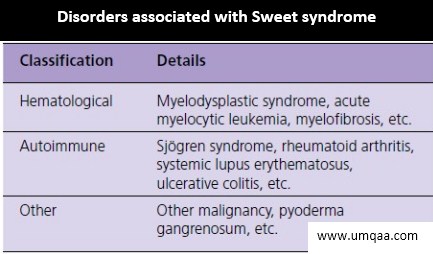Sweet syndrome:
Sweet syndrome, AKA acute febrile neutrophilic dermatosis, AKA Sweet’s disease, is characterized by pink-red to red-brown oedematous plaques that are frequently painful and occur primarily on the head, neck, and upper (and, less often, lower) extremities. Sweet syndrome should be considered in individuals with multiple nodules and plaques, often so edematous that they give the appearance of vesicles or bullae. Sweet syndrome was originally described in women with elevated white blood cell (WBC) counts. It is more common among women and persons 30-60 years old.
Pathogenesis:
- The disease is characterized by the presence of leukocytes in the lower dermis, with oedema of the papillary body.
- Oedema may give an impression of vesiculation, but on palpation, the lesions are solid, and vesicles probably never arise in this disease.
- Ironically, this disease is now usually seen in neutropenic patients with cancer (around 20% cases), most often in association with acute myeloid leukaemia (AML) but also in association with a variety of other malignancies.
- The idiopathic form of Sweet syndrome is seen more often in women, following a respiratory tract infection.
Etiology or associated (or found in) diseases/conditions:
- Yersinia
- Upper respiratory infection (A hypersensitivity against Streptococcus bacteria is a possible cause)
- Inflammatory bowel disease
- Systemic lupus erythematosus
- Pregnancy
- Solid tumours (primarily of the genitourinary tract)
- Malignancy (usually hematologic)
- Drugs: all-trans-retinoic acid, granulocyte colony-stimulating factor [G-CSF]) etc.
Clinical features:
- Skin manifestation: Tender red or bluish-red edematous nodules or papules that may coalesce and form sharply bordered plaques. The lesions are usually on the face, neck, upper extremities; when on lower extremities may mimic erythema nodosum.
- The patients also have a fever, headache, and arthralgia. Fever usually accompanies the development of the lesions.
- Extra-cutaneous sites of involvement include joints, muscles, eye, kidney (proteinuria, occasionally glomerulonephritis), and lung (neutrophilic infiltrates).
Differential diagnosis of Sweet syndrome:
- Neutrophilic eccrine hidradenitis
- Bullous forms of pyoderma gangrenosum, and
- Occasionally, cellulitis.
Investigations:
- Leukocytosis (Neutrophilia)
- High ESR (Usually accompanies the development of the lesions)
- High CRP
- A dense dermal infiltrate of neutrophils in the lesions.
- High ASO values may be observed when Streptococcus bacteria are involved.
Treatments:
- Treatment begins with high doses of glucocorticoids (prednisone, 60 mg/d) followed by tapered doses over the next 2-3 weeks.
- Both the lesions and the temperature elevation respond dramatically to glucocorticoid administration.
- Potassium iodide, NSAIDs, and colchicine are also effective treatment options.
Source:
- Harrison’s Principles of Internal Medicine 2 volumes 19th Edition; page: 132, 135, 366, 487; Figure 76e-73
- Shimizu's Dermatology 2nd Edition; page 150; Fig 9.3 & 9.4; Table








0 Comments